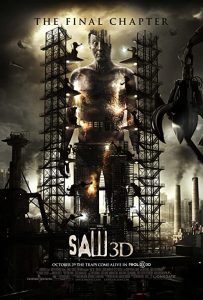 Saw 3D is, they say, the last Saw movie. It is important to note here that lots of horror franchises have made this claim before, and it is almost never true. But I am forced to judge the movie as though it is true, since that has importance in considering not just it for itself but the franchise as a whole. I say that last part because Saw is as far as I’m aware unique among horror series for having maintained a single coherent narrative throughout its run, a feat which has always caused me to give it a goodly amount of respect. There was this guy, and he got cancer. And it made him angry, because he was going to lose his life, while people that he interacted with were so careless with their own lives. So he got the idea to put these people into situations that forced them to make painful, committed choices in order to live. Most such people died, but some survived, and were usually a lot stronger for it.
Saw 3D is, they say, the last Saw movie. It is important to note here that lots of horror franchises have made this claim before, and it is almost never true. But I am forced to judge the movie as though it is true, since that has importance in considering not just it for itself but the franchise as a whole. I say that last part because Saw is as far as I’m aware unique among horror series for having maintained a single coherent narrative throughout its run, a feat which has always caused me to give it a goodly amount of respect. There was this guy, and he got cancer. And it made him angry, because he was going to lose his life, while people that he interacted with were so careless with their own lives. So he got the idea to put these people into situations that forced them to make painful, committed choices in order to live. Most such people died, but some survived, and were usually a lot stronger for it.
The last movie is explicitly about that, although Jigsaw’s survivors have always been important to the story as a whole. But in this instance, they have formed support groups, one of them has written a book and gone on tour, it’s really a whole theme. Quite a bit more compelling than last year’s indictment of the American healthcare industry, if only for being so much less hamfisted. So, there’s an interesting narrative. The devices, for a change, did not really impress me that much. They were every bit as squirmily uncomfortable to watch, don’t get me wrong, but they just didn’t feel as inventive as previous such deathtraps have been. But like I said earlier, the most important question is this: did the series as a whole come to a satisfactory conclusion?
Well, that’s a tricky question to answer. If you are looking for some kind of overarching lesson, or a note that neatly closes the theme that was played so heavily for the events of this specific movie and that loomed so large over the series as a whole, the one about being mentally strong enough to choose life? I don’t think it managed that.[1] If you are looking for narrative closure, that I think was achieved, and I’m glad to have seen it done. If you’re looking for a slight crack in the closed door, some light allowing for another sequel after all? Well, of course there was. It’s a horror movie. Duh.
On a technical note, the 3D right at the beginning of the movie had some severe issues, and the fact that they cleared up so fast makes me think this might be a limitation of the format, not the people processing this particular film. The opening scene involves one of the iconic traps, in a glass-enclosed room, in the middle of a public space where passersby can observe what is about to happen. As a result, there are a large amount of reflections as the camera looks in one direction or the other through the glass. And the reflections cast onto the glass really screw up the 3D effect badly. I think it is because the reflections have some amount of depth that they would not have in a real world situation, and then my eyes freak out because it looks so wrong? I’m not sure that’s what it was, only that my eyes were freaking out over whatever cause existed. So, 3D film-makers? Fix that, or avoid the situation. That is all.
[1] More to the point, I don’t think it tried. I wonder if they saw no way to do it, or if it didn’t cross their minds that they should have? Because if that had happened, I would have to be singing some praises right now.
Pingback: Jigsaw (2017) | Shards of Delirium